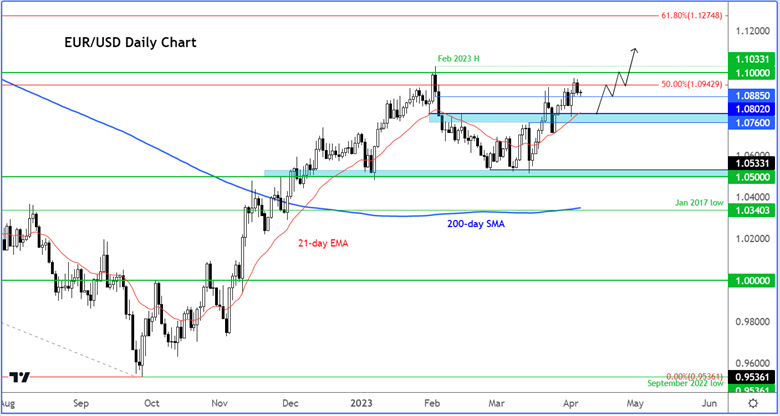The EUR/USD was unable to get to the 1.10 handle earlier this week, falling just 30 pips short of that level before easing back to below 1.0900 in the early European trade on Thursday, states Fawad Razaqzada of Trading Candles.
However, I reckon it is a matter of time before the EUR/USD breaks that barrier. That’s because recent data from the US has raised the likelihood of a recession in the world’s largest economy. In contrast, European data have been most encouraging in recent weeks, providing the ECB good reason to carry on with its rate-hiking to get record core inflation under control.
Before discussing the macro factors driving the single currency, let’s have a quick look at the EUR/USD chart.
EUR/USD’s Higher Lows Point to 1.10
The EUR/USD has been printing higher lows ever since it held key support around 1.05 in early March. The single currency’ ascend has been nice and steady, which can be both frustrating and a blessing in disguise for the bulls as it continually traps the bears. With price holding above the 21-day exponential moving average and key support at around 1.0800, the path of least resistance remains to the upside and so it remains on track to climb above the February high of 1.1033 in the not-too-distant future and US jobs data permitting. (See an up-to-date chart of the EUR/USD.)

Source: TradingView.com
German Recovery Gaining Momentum
Supporting the EUR/USD has been the publication of stronger-than-expected Eurozone data of late.
In Germany, the economic powerhouse of the Eurozone, industrial production jumped 2.0% month-over-month in February, easily beating the 0.1% increase forecast and adding to the 3.7% gain in January. The data comes after German factory orders surged 4.8% MoM the day before when also saw the eurozone composite PMI rise to a 10-month high.
As a result of the improvement in data, Germany is now expected to avoid a recession. Indeed, a couple of German economic institutes now think the Eurozone’s largest economy will grow this year. The IFO Institute, for example, thinks the economy would likely grow by 0.3% in 2023. Although this doesn’t sound much, a few months ago a deep recession seemed almost unavoidable.
The German economic recovery has been supported by the reopening of China and strong activity in the automotive sector. Indeed, earlier this week we saw German exports surge higher in February while imports also rose. More significantly, the German trade surplus has been noticeably higher at the start of this year compared to Q4.
The improving German economy and receding concerns over an energy crisis are why the German DAX index has been able to outperform its Wall Street peers so far this year, and why the EUR/USD has been able to get close to the 1.10 handle.
But It Is Not Just Germany
A few other Eurozone economies have also been doing relatively well, not least Spain, where the services sector has been going from strength to strength.
Spain's services PMI showed another sharp improvement, rising from an already good 56.7 reading in February to 59.4 in March, thus reaching its best level since November 2021. It easily surpassed market expectations again.
While the Eurozone economy is showing signs of strength, it remains to be seen whether that momentum will continue in the second half of the year. Rising interest rates from the ECB could hold growth back, while Russia’s war in Ukraine continues to pose additional risk. The OPEC’s decision to sharply cut oil production means higher oil prices which could keep inflationary pressures elevated for longer.
ECB Likely To Continue Rate Increases
Given the above macro considerations, I expect the ECB to raise interest rates at least a couple of more times before potentially pausing. Two 25 basis points rate rises in May and June would push monetary policy deeper into restrictive territory. This would further narrow the disparity between the ECB and Fed’s policies, thus underpinning the EUR/USD exchange rate.
US Labor Market Finally Shows Weakness Signs
With the Eurozone economy proving to remain more resilient than expected, we have seen some cracks start to appear in the US labor market, which is why the Dollar Index has remained under pressure. On Thursday, we saw the employment component of the ISM PMI falls sharply from the previous month’s 54.0 reading, although at 51.3 it remained in the positive territory. On top of this, the ADP Private Payrolls come in at 145K when 210K was expected. On Tuesday, we saw a big 630K drop in US job openings in February. These weaker employment indicators, which until now had been quite strong, certainly add to recession concerns, as data outside of the employment sector had already been weakening, including CPI.
Key Data to Watch For EUR/USD
The short-term focus will remain on US employment, as data this week has revealed some cracks in the US labor market. We have jobless claims data coming up later in the session on Thursday, followed by the monthly non-farm payroll report on Friday. Here are the key highlights in the economic calendar for the next week.
US Non-farm Payrolls Report (Friday, April Seventh)
This will probably be the most important macro-pointer this week. But given that many traders will be away in observance of Good Friday, we may have to wait until the next week to see the full impact of this on the EUR/USD. A lot of attention will be on the employment and wages aspects of the NFP report, as investors figure out whether more rate hikes will follow, or whether the Fed will hit the pause.
US CPI (Wednesday, April 12)
Thanks to weakness in US data, the market has been repricing lower than the Fed’s projected interest rate path in recent weeks, causing a significant downward move in the dollar. The market will continually question whether this is the right approach. So, much attention will be paid to CPI as investors try to front-run the Fed.
US Retail Sales (Friday, April 14)
The Fed’s rate projections have been cut sharply in recent weeks owing to weakness in US data and signs of peak inflation. Worries over the health of US consumers will intensify if we see a weaker print, especially as they are going to feel the impact of higher gasoline prices in light of OPEC’s decision to sharply cut crude production.
To learn more about Fawad Razaqzada visit TradingCandles.com.




















